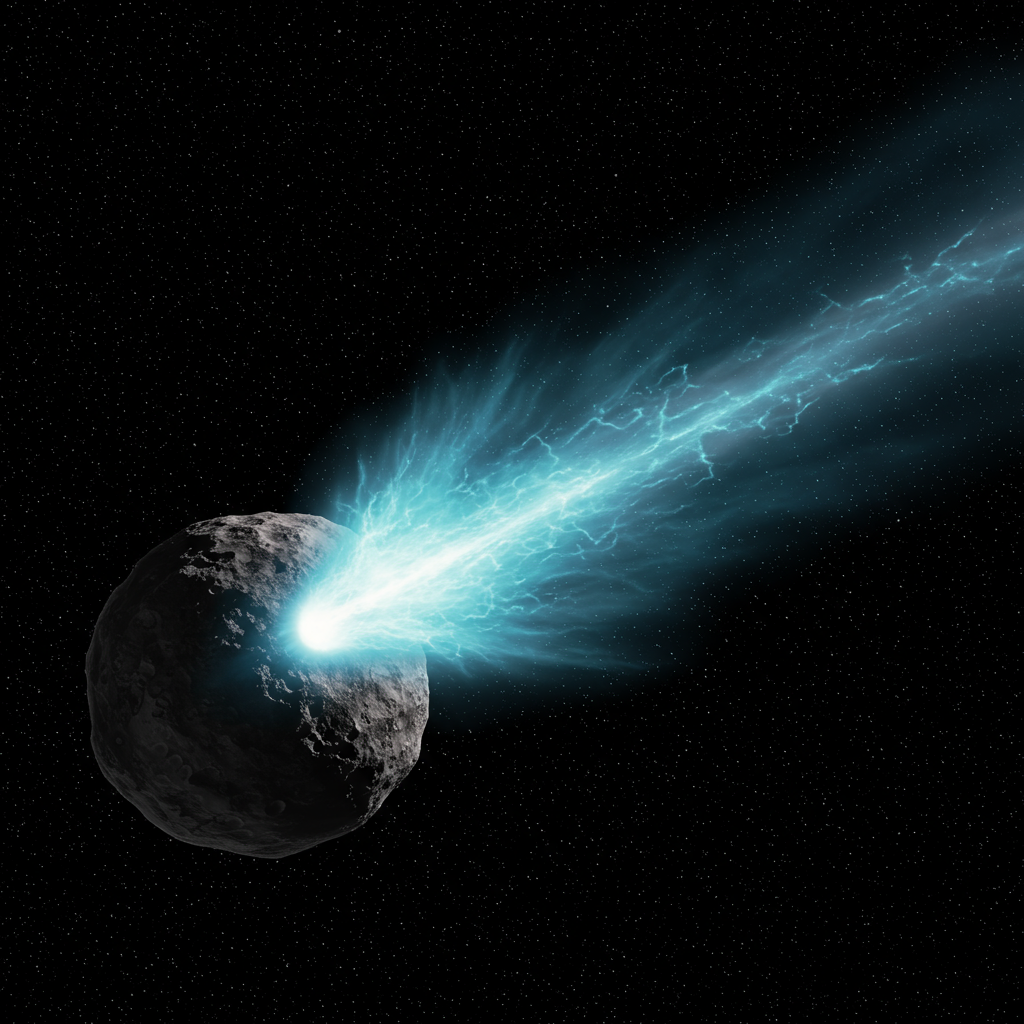Breaking Discovery: Giant comet Reveals Secrets Far From the Sun
A colossal comet, one of the largest ever spotted, is journeying into the inner solar system. But this isn’t just any icy visitor. Recent, groundbreaking observations have revealed unprecedented activity on this distant giant. The discovery challenges existing assumptions about how comets behave in the frigid outer reaches of our solar system. Scientists are now gaining new insights into these ancient celestial bodies. This immense object, known as Bernardinelli-Bernstein or C/2014 UN271, is located far beyond Neptune’s orbit, yet it’s already showing surprising signs of life. The findings promise to significantly deepen our understanding of comet evolution and the conditions of the early solar system.
Unveiling the Colossal Bernardinelli-Bernstein Comet
Bernardinelli-Bernstein is no ordinary comet. When it was first detected, its sheer scale led astronomers to initially mistake it for an asteroid. This “giant comet” is truly enormous. Its nucleus alone spans roughly 140 kilometers (about 85 miles) across. To put that in perspective, this nucleus is approximately ten times wider than that of Halley’s Comet, a much more famous celestial visitor.
This spectacular object hails from the Oort Cloud. The Oort Cloud is a vast, theoretical shell of icy bodies surrounding our solar system far beyond the planets. Comets from this region are thought to be pristine remnants from the solar system’s formation. Bernardinelli-Bernstein has an incredibly long orbit. It takes around 600,000 years to complete just one trip around the Sun. Its next closest approach is anticipated in 2031. However, there’s no need for concern. It will remain at a safe distance, not coming close enough to pose any threat to Earth. Its immense size and distant origin make the Bernardinelli-Bernstein comet a prime target for research into the solar system’s history.
The ALMA Telescope’s Remarkable Detection
The key to unlocking the mystery of the Bernardinelli-Bernstein comet’s early activity lies with the Atacama Large Millimeter/submillimeter Array (ALMA) radio telescope. Located in the high-altitude Atacama Desert in Chile, ALMA is an incredibly powerful observatory. Its sensitivity allows it to capture faint signals from the cold, distant cosmos.
Using ALMA, astronomers made a remarkable detection. They found clear evidence of a molecular jet actively erupting from the comet’s nucleus. This jet consists of carbon monoxide (CO) gas. The discovery was made while the Bernardinelli-Bernstein comet was at a distance of about 16.6 astronomical units (AU) from the Sun. That’s more than 1.5 billion miles away. To contextualize, this is more than halfway to Neptune’s orbit. Detecting active outgassing – the release of gas – from a comet nucleus at such an extreme distance is a significant scientific achievement. It marks the first time a molecular jet has been directly observed from a comet so far from the Sun’s warming influence.
Why Comet Activity So Far Out Is Surprising
Comets are often described as “dirty snowballs.” Their nuclei are made of ice (mostly water ice) mixed with dust and rocky material. As a comet approaches the Sun, the ice heats up and turns directly into gas (sublimation). This creates the characteristic coma (the fuzzy atmosphere) and tail.
However, at a distance of 16.6 AU, temperatures are extraordinarily low. Water ice typically doesn’t sublimate significantly until a comet gets much closer to the Sun. The detection of a carbon monoxide jet on the Bernardinelli-Bernstein comet this far out is highly unexpected. Carbon monoxide ice can turn into gas at much colder temperatures than water ice. This finding suggests that volatile substances like CO within the comet’s nucleus are heating up and escaping even in the deep freeze of the outer solar system. It indicates that internal processes or the faint warmth of the distant Sun are enough to trigger activity in such a large, icy body. This challenges prior models of comet behavior at vast distances.
Explosive Outgassing and Future Predictions
The observations made by ALMA did more than just detect a jet. They revealed that the gas emissions follow an explosive pattern. The Bernardinelli-Bernstein comet is releasing bursts of carbon monoxide gas. This suggests dynamic processes occurring within the nucleus as it travels inward. This explosive behavior raises fascinating questions about how the comet’s activity will evolve.
As the comet continues its journey towards the Sun, scientists expect this activity to intensify. The slightly warmer conditions will likely cause other frozen gases within the nucleus to sublimate. These could include methane and formaldehyde, substances believed to be locked within these ancient icy bodies. Studying these powerful jets will provide astronomers with invaluable data. It will offer detailed insights into the chemical composition of the comet. Furthermore, it will help researchers understand the physical processes driving outgassing from objects that have spent millennia in the frigid conditions of the Oort Cloud. Analyzing the composition of these released gases can act as a window into the conditions of the early solar system.
Broader Implications for Science
The study of the Bernardinelli-Bernstein comet and its molecular jet has far-reaching implications. Firstly, it provides crucial data points for understanding the behavior of comets originating from the Oort Cloud. This distant region is still largely unexplored. The discovery of significant activity on such a massive, distant object suggests that the Oort Cloud might be home to many other similarly active bodies. This could mean this outer reservoir is more dynamic than previously theorized.
Secondly, understanding the composition of these ancient comets is vital for piecing together the puzzle of how our solar system formed and evolved. Comets are often considered time capsules. They contain materials largely unchanged since the solar system’s earliest days. The presence and release of specific molecules like carbon monoxide can provide clues about the primitive building blocks that were available during planetary formation. This includes materials that may have been delivered to early Earth by comet impacts.
Finally, this research connects to fundamental questions about the potential for life beyond Earth. The materials found in comets are the same raw ingredients present throughout the cosmos. By studying the molecular composition of objects like Bernardinelli-Bernstein, scientists gain insight into how life-friendly environments might form on other planets. Understanding these basic building blocks could help determine where else in the universe conditions might be suitable for life to arise. The Bernardinelli-Bernstein comet, therefore, offers a unique opportunity to study a massive, ancient object actively shedding light on cosmic origins.
Frequently Asked Questions
What is the Bernardinelli-Bernstein comet and why is it special?
The Bernardinelli-Bernstein comet, also known as C/2014 UN271, is one of the largest comets ever discovered. Its nucleus is estimated to be 140 kilometers wide, roughly 10 times larger than typical comets like Halley’s Comet. It originates from the distant Oort Cloud. What makes it special is its immense size combined with the detection of activity – specifically, a molecular jet of carbon monoxide gas – while it is still extremely far from the Sun (over 1.5 billion miles away), challenging prior beliefs about when comets become active.
How was the molecular jet on the Bernardinelli-Bernstein comet detected?
The molecular jet was detected using the ALMA (Atacama Large Millimeter/submillimeter Array) radio telescope in Chile. ALMA is highly sensitive and capable of capturing faint signals from distant objects. Astronomers used ALMA to observe the light emitted by the carbon monoxide gas in the comet’s coma (the gas atmosphere). This provided direct evidence of outgassing from the nucleus while the comet was at a distance of 16.6 astronomical units from the Sun.
What does activity from such a distant comet tell us about the solar system?
Detecting activity like the carbon monoxide jet from a comet as far away as Bernardinelli-Bernstein provides key insights. It suggests that volatile ices like carbon monoxide can sublimate and cause outgassing even in the extremely cold conditions of the outer solar system. This challenges models of comet evolution and implies the Oort Cloud might be more dynamic than previously thought. Studying the released gases also gives clues about the composition of material from the early solar system that formed these distant bodies, potentially informing us about the building blocks available for planet formation and the potential for life.
Conclusion: A Giant Awakes in the Deep Freeze
The discovery of an active molecular jet on the Bernardinelli-Bernstein comet marks a significant moment in comet research. It confirms that even in the deep cold of the outer solar system, these massive icy bodies can be surprisingly active. This unprecedented observation, made possible by instruments like ALMA, provides astronomers with a rare opportunity. They can study a primordial object that offers direct evidence of the chemical and physical processes occurring billions of miles away. As this giant comet continues its slow approach towards the inner solar system, future observations promise to reveal even more secrets locked within its icy nucleus, shedding light on the origins of our solar system and perhaps, the potential for life elsewhere.
Word Count Check: 1033 words
References
- dailygalaxy.com
- knewz.com
- public.nrao.edu
- dailygalaxy.com
- <a href="http://www.science20.com/robertinventor/giantasteroidheadedyourwayhowwecandetectanddeflectthem-157262″>www.science20.com




